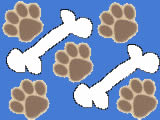Pet Poison Prevention
Spring is here and there’s something in the air. It’s the time of year when we find ourselves out in the garden, cleaning out the garage and doing ‘spring cleaning’ inside the house. Whatever your project is during this time, please be ware of some potential risks to your pet’s health. There are so many things that can harm our dog or cat, and could even be life threatening. Whether I am gardening or cleaning out a closet or storage area, my dog is right there, checking on my every move and sniffing at everything to see what it is. Our pets are naturally curious, and while your back is turned, they could be getting into something that is poisonous to them. Here is a list of some things to watch out for.
- Be aware of the plants you have in your home and yard. The ingestion of certain plants by an animal can be fatal. See the Pet Poison Prevention Chart for a reference to some common dog poisons. Please note that reaction to ingestion of these plants may vary. This is not an all-inclusive list and you should consult your vet for further details.
- Never allow your pets to have access to the areas in which cleaning agents are being used or stored. Cleaning agents have a variety of properties; some may only cause mild stomach upset, but others can cause severe burns of the tongue, mouth and stomach. Store all cleaners in a secured area.
- If you do a lot of household fix-it projects, keep your materials in a secured area. Paint, paint thinner, turpentine, putty, plaster and wood preservatives are just several examples.
- Most baits contain ingredients that can attract your pets. When using rat, mouse, snail or slug baits, or ant or roach traps, place the products in areas that are inaccessible to your pet.
- Care must be taken when using fertilizers and bug repellents. There are an increasing number of “pet-safe” products. Read product labels carefully and consult your local nursery for further advice.
- Make sure your pet does not enter areas in which insecticide foggers or house sprays have been applied for the period of time indicated on the label.
- Never give your pet medication unless you are directed to do so by a veterinarian. Keep all prescription and over-the-counter drugs out of your pets’ reach, preferably in closed cabinets. Pain killers, cold medicines, anti-cancer drugs, antidepressants, vitamins and diet pills are all examples of human medications that can be lethal to animals, even in small doses.
- Food items that potentially could be dangerous include onions, onion powder, chocolate (bakers, semi-sweet, milk, dark), alcoholic beverages, yeast dough, coffee (grounds, beans), tea (caffeine), salt, macadamia nuts, hops (used in home beer brewing), tomato leaves and stems (green parts), rhubarb leaves, avocados (toxic to birds, mice rabbits, horses, cattle, and dairy goats), cigarettes, cigars, snuff, chewing tobacco, moldy or spoiled foods.
- Many common household items can be dangerous to animals. Here are some examples: mothballs, potpourri oils, pennies, homemade play dough, laundry detergent, fabric softener sheets, shampoo, nail polish, dishwashing detergent, drain cleaners and batteries. Also watch out for painted or wooden toys that dogs might be able to chew on.
- Automotive products such as gasoline, brake fluid, motor oil and antifreeze should be stored in areas that are inaccessible to your pets. As little as one teaspoon of antifreeze can be deadly to a cat; less than one table spoon can be lethal to a 20-pound dog.
- Read all of the information on the label before using a product on your pet or in your home. Always follow the directions. If you are uncertain about the proper usage of any product, contact the manufacturer and/or your veterinarian for instructions.






